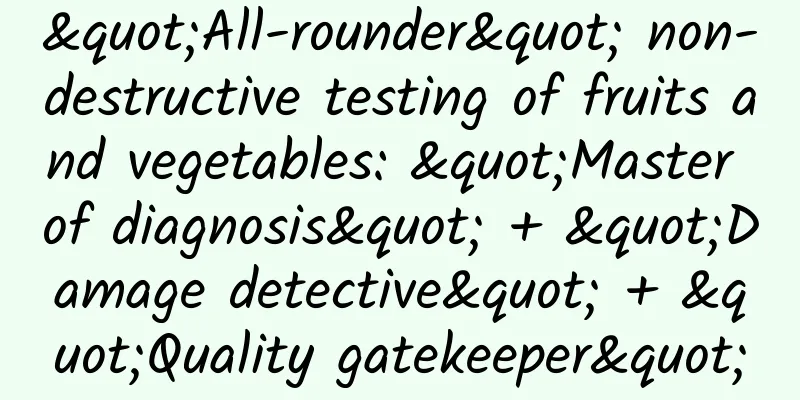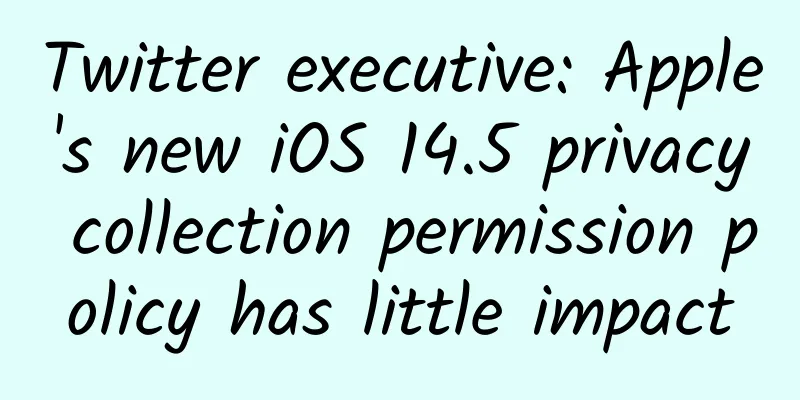"All-rounder" non-destructive testing of fruits and vegetables: "Master of diagnosis" + "Damage detective" + "Quality gatekeeper"

|
The planting, storage, transportation, sales and consumption of the fruit and vegetable industry are all complex and closely linked processes, which directly affect the stability and quality of the food supply chain. Farmers often say "depending on the weather for food", because the weather is closely related to the growth of fruits and vegetables, and the quality and safety of fruits and vegetables also bring challenges at different stages. However, with the continuous advancement of science and technology, non-destructive testing technology has emerged as a powerful assistant to improve the production and sales of fruits and vegetables. Planting stage: Master of "medical treatment" for fruits and vegetables Farmers often say that they rely on the weather for their livelihood, because most fruits and vegetables are grown outdoors, so their growth is closely related to the weather. For example, when the weather is bad, the photosynthesis of fruits and vegetables is hindered, and their yield may be reduced; when it rains for a long time and there is insufficient sunlight, bacteria are easily bred in a high humidity environment, which may cause various diseases of fruits and vegetables. If you want to intervene artificially before these situations occur or before they occur, you must first understand the growth status of fruits and vegetables, the fertilizer and water market, and the dynamics of pests and diseases in order to "prescribe the right medicine". This is when non-destructive testing technology comes into play. By using machine vision technology combined with high-throughput phenotypic analysis solutions, growers can mine phenotypic parameters such as vegetation index and leaf area index related to yield from large-scale aerial images, thereby measuring the size of fruits and vegetables and their distribution in the field. With this information, farmers can take various effective management measures in time before harvest to ensure the yield of fruits and vegetables and improve their marketability. Storage and transportation: the "damage detective" of fruit and vegetable transportation After harvesting, fruits and vegetables need to go through a series of storage, transportation and other links before they can be processed and sold. In this process, fruits and vegetables are extremely easy to be "injured". For example, physiological diseases caused by cold damage, frost damage, etc.; mechanical damage caused by squeezing, impact, etc.; and infectious diseases caused by pathogenic bacteria. Among them, physiological diseases and mechanical damage will aggravate the occurrence of infectious diseases, and infectious diseases are highly contagious during the storage period after fruits and vegetables are harvested. If the infected fruits and vegetables are not removed in time, it is easy to cause large-scale corruption and lesions, causing serious losses. It is reported that the post-harvest loss rate of fruits and vegetables in China is 15%-25%, and the direct economic losses are as high as 400 billion yuan. Relevant departments have conservatively estimated that the decay and loss of fruits and vegetables after harvest can almost meet the basic nutritional needs of 200 million people. Generally speaking, pathogens will invade fruits and vegetables in the early stages of their growth, and then remain dormant inside them. As fruits and vegetables mature, pathogens will grow and multiply inside them, causing lesions. However, in the early stages of the disease, no obvious symptoms of lesions can be observed on the surface of fruits and vegetables, so they cannot be discovered in time by relying on traditional manual testing. Nondestructive testing technology can fill this gap. It can capture details that cannot be observed by the naked eye. For example, electronic nose technology can well capture the changes in the types and contents of volatile organic compounds in fruits and vegetables after they have lesions. The changes in these components are closely related to the degree of lesions in fruits and vegetables. Therefore, farmers can use the data from electronic nose detection to dynamically monitor and conduct early warning and prevention of diseases in fruits and vegetables during storage and transportation, effectively ensuring the quality of fruits and vegetables. Sales link: the “quality gatekeeper” of fruit and vegetable grading When buying fruits and vegetables, you will find that some fruits and vegetables are labeled with words such as Class A and Class B. This is actually the grading of fruits and vegetables. The main purpose of fruit and vegetable grading is to make the products meet the standards of commercialization. The quality of fruits and vegetables is affected by many natural environmental and human factors. The quality of fruits and vegetables in different orchards or different fruit trees in the same orchard, or even fruits from different parts of the same fruit tree, cannot be exactly the same. Through grading, products that do not meet the standards such as diseased, insect-infested, injured, and rotten fruits can be eliminated, and fruits and vegetables with consistent specifications can be packaged and sold. Different grades mean different "values". Through grading, sellers can negotiate prices according to quality, achieve high quality and high prices, and maximize benefits. The grading of fruits and vegetables is an indispensable part of the fruit and vegetable industrialization process. Non-destructive testing technology is far superior to traditional manual testing in terms of labor costs, testing accuracy, and testing loss. It can greatly speed up the process of fruit and vegetable quality evaluation and meet the demand for fast and efficient testing technology in the fruit and vegetable industrialization process. Consumption stage: Personalized customized "big data development plan" For consumers who consume fruits and vegetables at the last stop, under the current trend of "quality and enjoyment" economy, the consumption level of the general public has been greatly improved, and people's pursuit of dietary nutrition has also reached a new level. Compared with the past emphasis on cost performance, today's consumers are more concerned about the freshness, quality, nutritional value and appearance of fruits and vegetables. On the basis of quality standardization, consumers' pursuit of fruit and vegetable quality is becoming increasingly personalized. In recent years, "adoption" agriculture has developed rapidly. Consumers rent a piece of land online and cultivate it themselves or let farmers grow it according to their requirements to achieve "personal customization" of fruits and vegetables. In this process, consumers can remotely monitor the growth of fruits and vegetables they adopt through the Internet, and the realization of this process is also inseparable from the support of non-destructive testing technology. With the support of Internet of Things technology, non-destructive testing technology is used to monitor important parameters such as crop growth, soil temperature and humidity, light intensity, and insect infestation, which helps to achieve precise planting, visual management, and intelligent decision-making of fruits and vegetables. With the supply-side reform of my country's agriculture and the improvement of people's living standards, the public's consumption concept has changed from the primary demand of "eating enough" to the higher requirement of "eating well", and the quality requirements for fruits and vegetables are becoming higher and higher. The widespread application of non-destructive testing technology not only improves the efficiency of fruit and vegetable production and reduces losses, but also provides consumers with higher quality choices. The development of this technology will continue to shape the fruit and vegetable supply chain, provide more possibilities for refined planting, storage, sales and consumption, and realize a more intelligent, sustainable and high-quality fruit and vegetable industry. Produced by: Popular Science in China to Benefit Farmers Scientific Advisor: Guo Zhiming (Professor, School of Food and Bioengineering, Jiangsu University) Co-ordinators: Liao Danfeng, Zheng Fengmao, Wang Changhai, Zhang Ruijie Planning: Wu Yuetong Editor: Wang Yuanyuan (internship) |
<<: Is “boiling tableware with boiling water” just a ritual? Is it necessary? Here comes the truth!
>>: Seeing the "bones" of the cosmic ghost hand
Recommend
The host scored the first goal! Hisense Fresh Air Conditioner builds industry IP on the world stage
At 21:00 on November 25th, Beijing time, the matc...
Taking Xiaomi and Hammer as examples, we can explain the two pricing logics of products
· There is a classic textbook in American marketi...
For those of you who are “flying” home for the New Year, please check out the “Safety Guide for Flight Attendants in Cold Weather”!
The annual grand "human migration" - Sp...
What optimization work should be done on Baidu bidding hosting account every day?
What optimization work should the Baidu bidding h...
WeChat data structure
@Fenng from "Gossip" posted three inter...
First experience with Samsung Galaxy Core Max, the new product of S5 worth 1,000 yuan
Looking Ahead As the fifth generation product of ...
What are the requirements for tomb sweeping during Qingming Festival in 2022? What date does it usually start and end?
Tomb sweeping on Qingming Festival is a kind of to...
How to write an activity plan? Here are 3 great tips!
At work, we often encounter such problems: The co...
CCTV 3.15 exposed that Nikon was politically suppressed: Who believes it?
During the 3.15 period this year, CCTV's 3.15 ...
Which is better, mini program or micro mall? What are the specific differences?
Which one is better, mini program or micro mall? ...
This kind of fossil is called the "time pointer" of the rock layer
During its long geological development and evolut...
How to operate a community from 0 to 1?
To operate a community well, three points are ver...
A couple in Yangzhou was unfortunately electrocuted to death in the flooded road. Summer is the flood season. How can we avoid the danger of electric shock on rainy days?
Copyrighted images from the gallery, unauthorized...
38 industry terms for live streaming sales
Live streaming sales are very popular nowadays, s...









